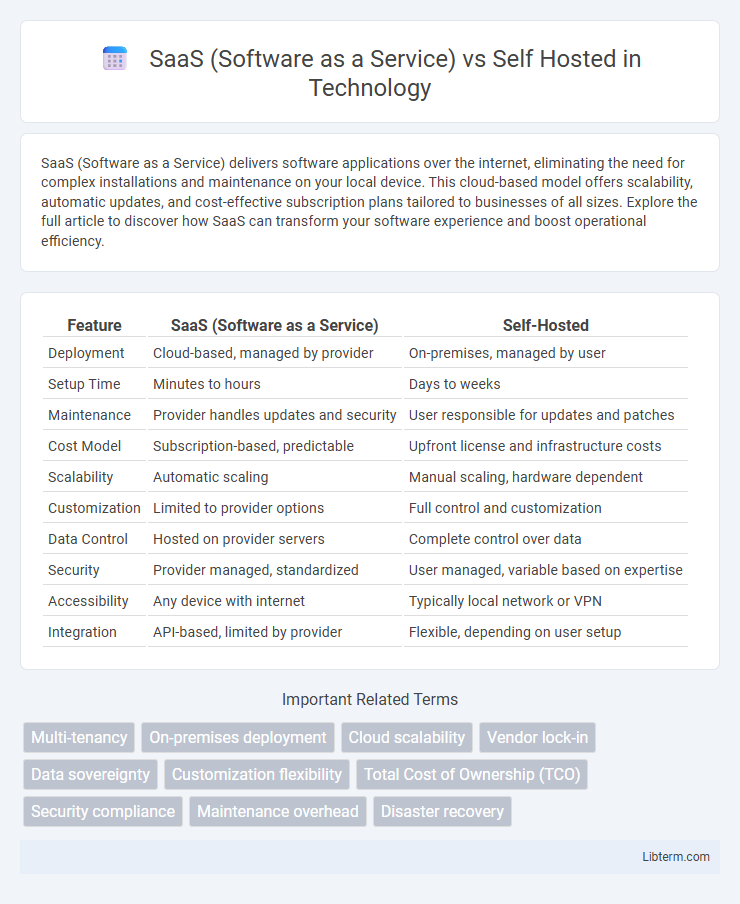SaaS (Software as a Service) delivers software applications over the internet, eliminating the need for complex installations and maintenance on your local device. This cloud-based model offers scalability, automatic updates, and cost-effective subscription plans tailored to businesses of all sizes. Explore the full article to discover how SaaS can transform your software experience and boost operational efficiency.
Table of Comparison
| Feature | SaaS (Software as a Service) | Self-Hosted |
|---|---|---|
| Deployment | Cloud-based, managed by provider | On-premises, managed by user |
| Setup Time | Minutes to hours | Days to weeks |
| Maintenance | Provider handles updates and security | User responsible for updates and patches |
| Cost Model | Subscription-based, predictable | Upfront license and infrastructure costs |
| Scalability | Automatic scaling | Manual scaling, hardware dependent |
| Customization | Limited to provider options | Full control and customization |
| Data Control | Hosted on provider servers | Complete control over data |
| Security | Provider managed, standardized | User managed, variable based on expertise |
| Accessibility | Any device with internet | Typically local network or VPN |
| Integration | API-based, limited by provider | Flexible, depending on user setup |
Introduction to SaaS and Self-Hosted Solutions
SaaS (Software as a Service) delivers applications over the internet, allowing users to access software without local installation or maintenance, which reduces upfront costs and simplifies updates. Self-hosted solutions require organizations to install and manage software on their own servers, providing greater control, customization, and security but demanding higher IT resources and infrastructure. Understanding the trade-offs between SaaS convenience and self-hosted autonomy is essential for selecting the right software deployment model.
Core Differences Between SaaS and Self-Hosted Software
SaaS (Software as a Service) offers cloud-based access where the provider manages infrastructure, updates, and security, enabling rapid deployment and scalability. Self-hosted software requires local installation on in-house servers, giving organizations full control over customization, data security, and compliance but demanding ongoing maintenance and IT resources. Key differences include cost models--subscription-based for SaaS versus upfront licensing for self-hosted--along with flexibility, data ownership, and dependency on internet connectivity.
Cost Comparison: SaaS vs Self-Hosted
SaaS solutions typically involve predictable subscription fees that cover hosting, maintenance, and support, reducing upfront investment and operational costs. Self-hosted software requires significant initial capital for hardware, licenses, and IT infrastructure, along with ongoing expenses for system administration and upgrades. Over time, SaaS often proves more cost-efficient for small to medium businesses, while self-hosted may provide lower long-term costs for large enterprises with dedicated IT resources.
Security Considerations in SaaS vs Self-Hosting
SaaS platforms offer robust, enterprise-grade security measures including automated updates, continuous monitoring, and compliance with industry standards like GDPR and HIPAA, which can be challenging for self-hosted solutions to maintain consistently. Self-hosted environments provide greater control over data storage and security protocols, allowing customization tailored to specific organizational policies but require dedicated IT resources to manage vulnerabilities and patch software. Organizations must weigh the trade-offs between SaaS's built-in security infrastructure and self-hosting's customizable but resource-intensive security management when addressing data protection and regulatory compliance.
Scalability and Performance: SaaS vs Self-Hosted
SaaS platforms offer automatic scalability through cloud infrastructure, enabling seamless performance during traffic spikes without manual intervention. Self-hosted solutions require dedicated hardware upgrades and resource management to scale, which can introduce latency and downtime risks. Performance in SaaS is optimized by provider-managed load balancing, whereas self-hosted setups depend heavily on internal IT expertise and infrastructure capacity.
Customization and Integration Capabilities
SaaS solutions offer limited customization options confined to predefined settings, often restricting deep system modifications, while self-hosted software provides extensive customization flexibility tailored to specific business requirements. Integration capabilities in SaaS depend on API availability and third-party connectors, which may limit seamless interoperability compared to self-hosted platforms that allow full control over integration methods and data flow. Businesses prioritizing advanced customization and complex integrations typically prefer self-hosted environments for maximum adaptability and control.
Maintenance and Support Responsibilities
In SaaS, maintenance and support responsibilities fall primarily on the service provider, ensuring automatic updates, security patches, and 24/7 technical assistance without user intervention. Self-hosted solutions require internal teams to manage software updates, hardware maintenance, security protocols, and troubleshooting, increasing operational overhead. The choice impacts resource allocation, with SaaS reducing in-house IT burdens while self-hosting demands comprehensive technical expertise and dedicated staff.
Data Ownership and Compliance
SaaS solutions provide convenience but often involve relinquishing direct data ownership to third-party providers, raising concerns over compliance with regulations such as GDPR and HIPAA. Self-hosted environments grant organizations full control over data storage, security protocols, and compliance measures, enabling tailored adherence to industry-specific standards. Businesses prioritizing stringent data governance and regulatory compliance frequently prefer self-hosting to mitigate risks related to data sovereignty and breach accountability.
Use Cases: When to Choose SaaS or Self-Hosted
SaaS platforms are ideal for businesses seeking rapid deployment, minimal IT management, and scalable solutions, especially for startups or companies with limited technical resources. Self-hosted solutions suit organizations requiring full control over data, enhanced customization, compliance with strict security standards, or integration with proprietary systems. Enterprises handling sensitive information or operating in regulated industries often prefer self-hosted to maintain data sovereignty and tailor software to unique workflows.
Final Decision: Which Model Is Right for Your Business?
Choosing between SaaS and self-hosted solutions depends on factors like budget, control requirements, scalability, and IT expertise. SaaS offers easier setup, lower upfront costs, and automatic updates, ideal for businesses prioritizing agility and minimal maintenance. Self-hosted provides full customization, data control, and potential long-term cost savings, making it suitable for organizations with strict security policies and dedicated IT teams.
SaaS (Software as a Service) Infographic

 libterm.com
libterm.com